
Edward Harold Browne was a bishop of the Church of England.

Buckland-Tout-Saints is a village and civil parish in the South Hams district of Devon, England. In the 2001 census it had a population of 178, up from a population of only 37 in 1901. The parish also includes the hamlets of Bearscombe, Goveton and Ledstone. The parish is surrounded clockwise from the north by the parishes of Woodleigh, East Allington, Frogmore and Sherford, Kingsbridge, Churchstow, and a short boundary with Loddiswell.

East Allington is a village and civil parish in the South Hams district of Devon, England, three miles (5 km) south of Halwell and just off the A381 road. It lies about three miles (5 km) from Kingsbridge and about ten miles (16 km) from Totnes. The coast at Slapton Sands is about five miles (8 km) to the south-east. Also in the parish is the hamlet of The Mounts, about one mile (1.6 km) away.
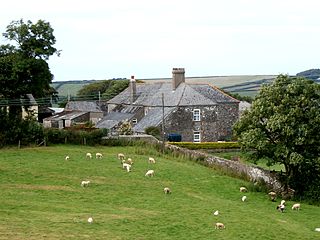
Halsbury is a historic manor in the parish of Parkham in North Devon, England. It is situated 2 miles north-east of the village of Parkham and 4 miles south-west of the town of Bideford. Halsbury was long a seat of the ancient Giffard family, a distant descendant of which was the celebrated lawyer Hardinge Stanley Giffard, 1st Earl of Halsbury (1823–1921), who adopted the name Halsbury for his earldom and was the author of the essential legal reference books Halsbury's Statutes. Halsbury Barton, now a farmhouse, retains 16th- and 17th-century elements of the former manor house of the Giffard family. It was described in a record of 1560 as a "new dwelling house".
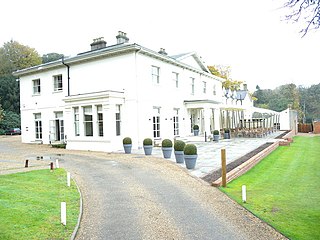
Kesgrave Hall is a country house located in woodlands north of the town of Kesgrave, which itself is on the eastern outskirts of Ipswich, in Suffolk, England. It was constructed in 1812 by William Cunliffe-Shawe, and has been extended since, notably by the addition of a northern extension. The building has five large rooms downstairs, with another two in the northern extension, with a further seven upstairs.
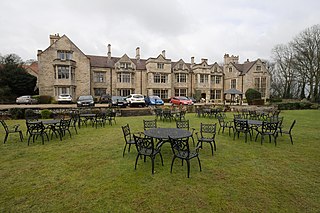
Redworth Hall is a 17th-century country house at Redworth, Heighington, County Durham, England now converted to a hotel. It is a listed building.

Pennyhill Park Hotel is a 19th-century country house hotel and spa in Bagshot, Surrey in the south east of England.

Hoole Hall is a former country house located to the north of Chester, Cheshire, England. It originated as a small house in about 1760, built for the Rev John Baldwin. After Rev Baldwin's death in 1793, the house passed to his eldest son, Thomas Baldwin, who then sold the house and surrounding land in 1800.

Marshall Meadows House is a Georgian mansion and the most northerly hotel in England, located north of Berwick-upon-Tweed, Northumberland, in northeastern England. Currently trading as Marshall Meadows Manor House, the hotel is set in 15 acres (6.1 ha) of grounds only 275 metres (902 ft) from the border with Scotland.

Ravenscroft Hall is a country house standing to the east of the B5309 road about 1 mile (1.6 km) to the north of Middlewich, Cheshire, England. The house was built in 1837 for William T. Buchanan, replacing a former Jacobean house. It was extended, possibly in 1852 when the house was bought by the Moss family, and again in 1877. The house has since been divided into two dwellings. It is constructed in roughcast and yellow brick, with stone dressings and slate roofs. The house is in two storeys, with a main front of five bays, and a five-bay extension to the northeast. The garden front also has five bays. The house has an Ionic porch, and an Italianate belvedere. It is recorded in the National Heritage List for England as a designated Grade II listed building.

Heanton Satchville was a historic manor in the parish of Petrockstowe, North Devon, England. With origins in the Domesday manor of Hantone, it was first recorded as belonging to the Yeo family in the mid-14th century and was then owned successively by the Rolle, Walpole and Trefusis families. The mansion house was destroyed by fire in 1795. In 1812 Lord Clinton purchased the manor and mansion of nearby Huish, renamed it Heanton Satchville, and made it his seat. The nearly-forgotten house was featured in the 2005 edition of Rosemary Lauder's "Vanished Houses of North Devon". A farmhouse now occupies the former stable block with a large tractor shed where the house once stood. The political power-base of the Rolle family of Heanton Satchville was the pocket borough seat of Callington in Cornwall, acquired in 1601 when Robert Rolle purchased the manor of Callington.

The hall house is a type of vernacular house traditional in many parts of England, Wales, Ireland and lowland Scotland, as well as northern Europe, during the Middle Ages, centring on a hall. Usually timber-framed, some high status examples were built in stone.

Edward Bowring Stephens, was a British sculptor from Devon. He was honorary secretary of the Institute of Sculptors circa 1861.
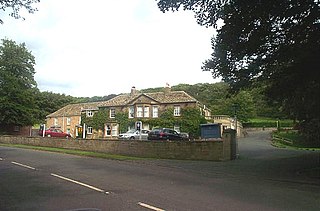
Wentbridge House Hotel near Pontefract, West Yorkshire, England, is an historical house of significance. It dates from 1700 and is built in the Georgian style. The house was occupied by many interesting people and was owned at one period by the Sayle family who lived in this area for several centuries. The property is now a hotel and provides accommodation, dining and function facilities
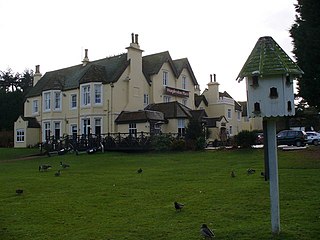
Worplesdon Place Hotel near Guildford, Surrey is a house of historical significance. It appears to have been built in about 1845 by Sir William Bovill. It was a private residence for the next 100 years and was owned by several notable people. In the 1950s it became a hotel and still operates in this manner today. The hotel provides accommodation and restaurant facilities and caters for special events particularly weddings.

Gittisham is an historic manor largely co-terminous with the parish of Gittisham in Devon, England, within which is situated the village of Gittisham. The capital estate is Combe, on which is situated Combe House, the manor house of Gittisham, a grade I listed Elizabethan building situated 2 1/4 miles south-west of the historic centre of Honiton and 3 1/4 miles north-east of the historic centre of Ottery St Mary.

The Manor of Groves Hotel in High Wych, near Sawbridgeworth in Hertfordshire is a building of historical significance and is listed as Grade II on the English Heritage Register. It was remodelled over an existing older building in 1823 by a prominent London lawyer. The house was a private residence for many distinguished people over the next 150 years and in 1988 was converted to a hotel. It still serves this function and provides accommodation, dining facilities and caters for events such as conferences and weddings. There is also a golf course.

Cotswold Grange Hotel in Cheltenham is a building of historical significance. It was built in about 1840 as a private residence and was home to many notable people over the next century. It is now a hotel which provides accommodation and event services.

Lympstone Manor in Exmouth, England, is a building of historical significance and is Grade II listed on the English Heritage Register. It was mainly built in the 1760s around an older building which had been used as a farmhouse. At this time the owner was Charles Baring, a wealthy banker who had just been married. It was the residence of many notable people for the next two centuries. Today it is a hotel, restaurant and vineyard. The house has never held the Manorship of Lymstone, which instead has traditionally been associated with Nutwell Court.

The Old Hall Hotel in Coundon near Coventry, England, is a building of historical significance and is Grade II listed on the English Heritage Register. It was built in about 1800 by a wealthy landowner and was called Coundon Villa and later Coundon Hall. It was the residence of several notable people until about 1947, when it was converted to a hotel. Today it is still a hotel which provides accommodation, restaurant and bar facilities.
























